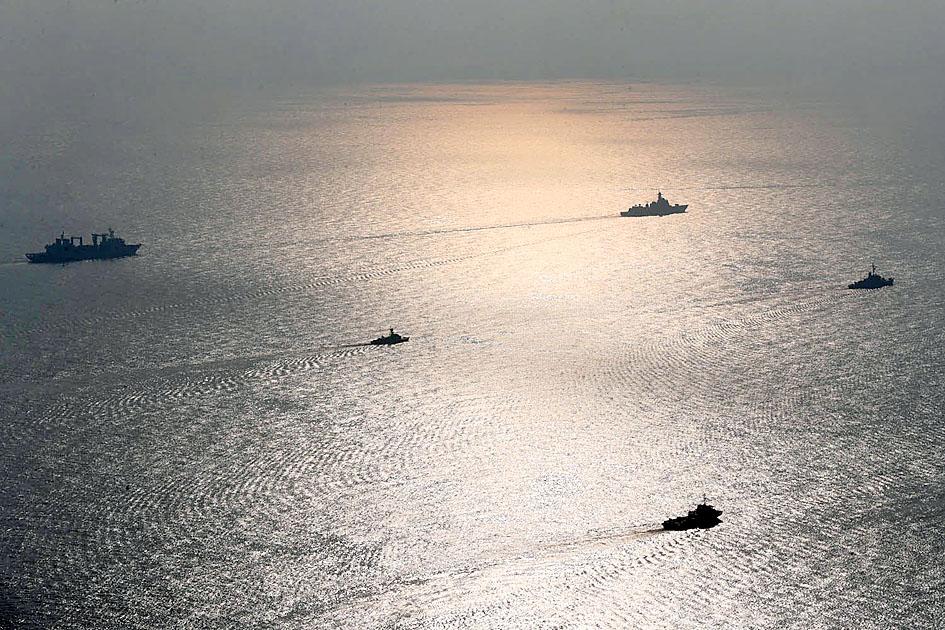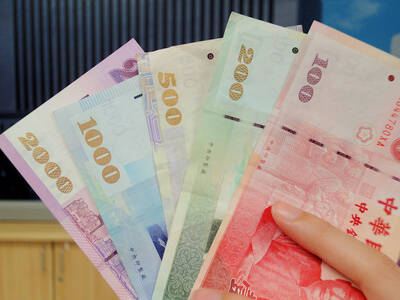China, Iran and Russia yesterday began joint naval drills in the Indian Ocean aimed at boosting marine security, Iranian state media reported.
Eleven Iranian vessels were joined by three Russian ships including a destroyer, and two Chinese vessels, state TV said.
Iran’s Revolutionary Guard would also participate with smaller ships and helicopters, it added.

Photo: AFP
The report said the maneuvers would cover about 17,000km2 of the northern Indian Ocean, and include night fighting, rescue operations and firefighting drills.
It is the third joint naval drill between the countries since 2019.
It coincided with a visit by Iranian President Ebrahim Raisi to Russia that ended on Thursday.
“Improving bilateral relations between Tehran and Moscow will enhance security for the region and the international arena,” Raisi said upon returning from Russia yesterday, the official IRNA news agency reported.
Tehran has sought to step up military cooperation with Beijing and Moscow amid regional tensions with the US.
Visits to Iran by Russian and Chinese naval representatives have also increased over the past few years.
Iran has been holding regular military drills since the middle of last year, as attempts to revive its 2015 nuclear deal with world powers flounder.
Russia is also at loggerheads with the US and the West over Ukraine, where it has sent about 100,000 troops that Washington, Kiev and their allies fear would be used to invade the country.
Russia on Thursday announced sweeping naval maneuvers in multiple areas involving the bulk of its naval potential — more than 140 warships and more than 60 aircraft — to last through next month.
The exercises would be in the Black Sea, the Mediterranean, the northeastern Atlantic and the Pacific Ocean, in addition to the joint exercise with Iran in the Indian Ocean, it said.

People can preregister to receive their NT$10,000 (US$325) cash distributed from the central government on Nov. 5 after President William Lai (賴清德) yesterday signed the Special Budget for Strengthening Economic, Social and National Security Resilience, the Executive Yuan told a news conference last night. The special budget, passed by the Legislative Yuan on Friday last week with a cash handout budget of NT$236 billion, was officially submitted to the Executive Yuan and the Presidential Office yesterday afternoon. People can register through the official Web site at https://10000.gov.tw to have the funds deposited into their bank accounts, withdraw the funds at automated teller

PEACE AND STABILITY: Maintaining the cross-strait ‘status quo’ has long been the government’s position, the Ministry of Foreign Affairs said Taiwan is committed to maintaining the cross-strait “status quo” and seeks no escalation of tensions, the Ministry of Foreign Affairs (MOFA) said yesterday, rebutting a Time magazine opinion piece that described President William Lai (賴清德) as a “reckless leader.” The article, titled “The US Must Beware of Taiwan’s Reckless Leader,” was written by Lyle Goldstein, director of the Asia Program at the Washington-based Defense Priorities think tank. Goldstein wrote that Taiwan is “the world’s most dangerous flashpoint” amid ongoing conflicts in the Middle East and Russia’s invasion of Ukraine. He said that the situation in the Taiwan Strait has become less stable

CONCESSION: A Shin Kong official said that the firm was ‘willing to contribute’ to the nation, as the move would enable Nvidia Crop to build its headquarters in Taiwan Shin Kong Life Insurance Co (新光人壽) yesterday said it would relinquish land-use rights, or known as surface rights, for two plots in Taipei’s Beitou District (北投), paving the way for Nvidia Corp to expand its office footprint in Taiwan. The insurer said it made the decision “in the interest of the nation’s greater good” and would not seek compensation from taxpayers for potential future losses, calling the move a gesture to resolve a months-long impasse among the insurer, the Taipei City Government and the US chip giant. “The decision was made on the condition that the Taipei City Government reimburses the related

FRESH LOOK: A committee would gather expert and public input on the themes and visual motifs that would appear on the notes, the central bank governor said The central bank has launched a comprehensive redesign of New Taiwan dollar banknotes to enhance anti-counterfeiting measures, improve accessibility and align the bills with global sustainability standards, Governor Yang Chin-long (楊金龍) told a meeting of the legislature’s Finance Committee yesterday. The overhaul would affect all five denominations — NT$100, NT$200, NT$500, NT$1,000 and NT$2,000 notes — but not coins, Yang said. It would be the first major update to the banknotes in 24 years, as the current series, introduced in 2001, has remained in circulation amid rapid advances in printing technology and security standards. “Updating the notes is essential to safeguard the integrity